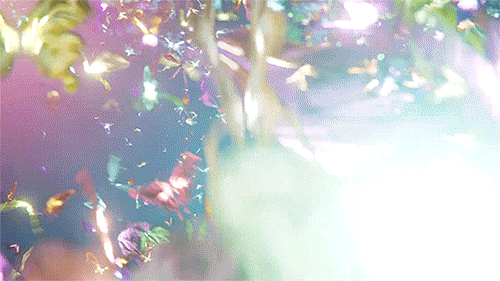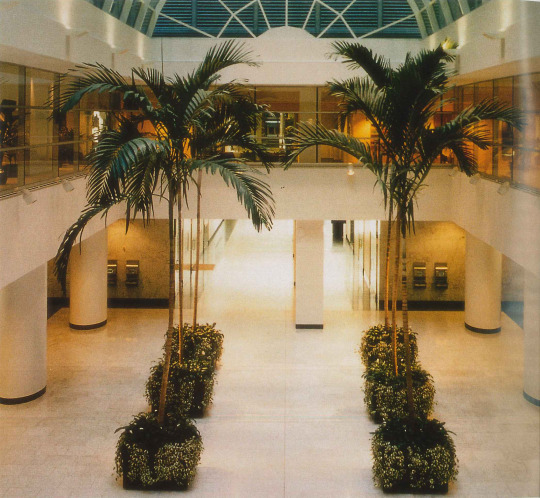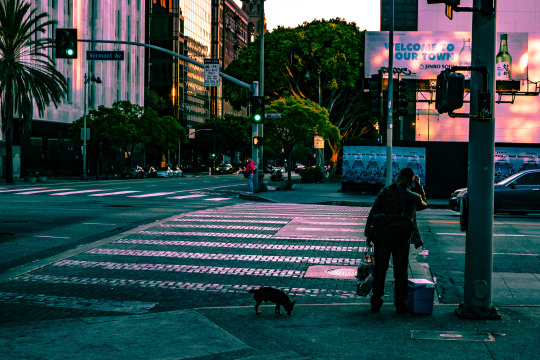#Lo Green
Text
As relentless rains pounded LA, the city’s “sponge” infrastructure helped gather 8.6 billion gallons of water—enough to sustain over 100,000 households for a year.
Earlier this month, the future fell on Los Angeles. A long band of moisture in the sky, known as an atmospheric river, dumped 9 inches of rain on the city over three days—over half of what the city typically gets in a year. It’s the kind of extreme rainfall that’ll get ever more extreme as the planet warms.
The city’s water managers, though, were ready and waiting. Like other urban areas around the world, in recent years LA has been transforming into a “sponge city,” replacing impermeable surfaces, like concrete, with permeable ones, like dirt and plants. It has also built out “spreading grounds,” where water accumulates and soaks into the earth.
With traditional dams and all that newfangled spongy infrastructure, between February 4 and 7 the metropolis captured 8.6 billion gallons of stormwater, enough to provide water to 106,000 households for a year. For the rainy season in total, LA has accumulated 14.7 billion gallons.
Long reliant on snowmelt and river water piped in from afar, LA is on a quest to produce as much water as it can locally. “There's going to be a lot more rain and a lot less snow, which is going to alter the way we capture snowmelt and the aqueduct water,” says Art Castro, manager of watershed management at the Los Angeles Department of Water and Power. “Dams and spreading grounds are the workhorses of local stormwater capture for either flood protection or water supply.”
Centuries of urban-planning dogma dictates using gutters, sewers, and other infrastructure to funnel rainwater out of a metropolis as quickly as possible to prevent flooding. Given the increasingly catastrophic urban flooding seen around the world, though, that clearly isn’t working anymore, so now planners are finding clever ways to capture stormwater, treating it as an asset instead of a liability. “The problem of urban hydrology is caused by a thousand small cuts,” says Michael Kiparsky, director of the Wheeler Water Institute at UC Berkeley. “No one driveway or roof in and of itself causes massive alteration of the hydrologic cycle. But combine millions of them in one area and it does. Maybe we can solve that problem with a thousand Band-Aids.”
Or in this case, sponges. The trick to making a city more absorbent is to add more gardens and other green spaces that allow water to percolate into underlying aquifers—porous subterranean materials that can hold water—which a city can then draw from in times of need. Engineers are also greening up medians and roadside areas to soak up the water that’d normally rush off streets, into sewers, and eventually out to sea...
To exploit all that free water falling from the sky, the LADWP has carved out big patches of brown in the concrete jungle. Stormwater is piped into these spreading grounds and accumulates in dirt basins. That allows it to slowly soak into the underlying aquifer, which acts as a sort of natural underground tank that can hold 28 billion gallons of water.
During a storm, the city is also gathering water in dams, some of which it diverts into the spreading grounds. “After the storm comes by, and it's a bright sunny day, you’ll still see water being released into a channel and diverted into the spreading grounds,” says Castro. That way, water moves from a reservoir where it’s exposed to sunlight and evaporation, into an aquifer where it’s banked safely underground.
On a smaller scale, LADWP has been experimenting with turning parks into mini spreading grounds, diverting stormwater there to soak into subterranean cisterns or chambers. It’s also deploying green spaces along roadways, which have the additional benefit of mitigating flooding in a neighborhood: The less concrete and the more dirt and plants, the more the built environment can soak up stormwater like the actual environment naturally does.
As an added benefit, deploying more of these green spaces, along with urban gardens, improves the mental health of residents. Plants here also “sweat,” cooling the area and beating back the urban heat island effect—the tendency for concrete to absorb solar energy and slowly release it at night. By reducing summer temperatures, you improve the physical health of residents. “The more trees, the more shade, the less heat island effect,” says Castro. “Sometimes when it’s 90 degrees in the middle of summer, it could get up to 110 underneath a bus stop.”
LA’s far from alone in going spongy. Pittsburgh is also deploying more rain gardens, and where they absolutely must have a hard surface—sidewalks, parking lots, etc.—they’re using special concrete bricks that allow water to seep through. And a growing number of municipalities are scrutinizing properties and charging owners fees if they have excessive impermeable surfaces like pavement, thus incentivizing the switch to permeable surfaces like plots of native plants or urban gardens for producing more food locally.
So the old way of stormwater management isn’t just increasingly dangerous and ineffective as the planet warms and storms get more intense—it stands in the way of a more beautiful, less sweltering, more sustainable urban landscape. LA, of all places, is showing the world there’s a better way.
-via Wired, February 19, 2024
#california#los angeles#water#rainfall#extreme weather#rain#atmospheric science#meteorology#infrastructure#green infrastructure#climate change#climate action#climate resilient#climate emergency#urban#urban landscape#flooding#flood warning#natural disasters#environmental news#climate news#good news#hope#solarpunk#hopepunk#ecopunk#sustainability#urban planning#city planning#urbanism
14K notes
·
View notes
Text




Alicent watching her son Aemond who was maimed by Luke (S1EP7) vs Alicent seeing her son Aegon II who was maimed by Aemond (S2EP5) 🔪 inspiration
#aegon ii targaryen#thank you Lo for the inspiration! 💔#lauraneedstochilledits#hotd spoilers#alicent hightower#aemond targaryen#hotd S2#hotd S1#house of the dragon#olivia cooke#tom glynn carney#hotdedits#welighttheway#hotdgifs#targaryensource#hotdcentral#gameofthronesdaily#targnation#the greens#house of the dragon tv show#hotd
4K notes
·
View notes
Text

The Los Angeles House: Decoration and Design in America's 20th-Century City, 1995
#vintage#vintage interior#interior design#home decor#home#architecture#style#1990s#Lloyd Wright#Los Angeles#California#pool#modern#mint green#tile
2K notes
·
View notes
Text



#los angeles#photographers on tumblr#street photography#artists on tumblr#original photographers#fuji#fujifilm#xt2#neon#glow#green#blue#teal#red#night#graffiti
2K notes
·
View notes
Text





FFXIV Dawntrail - New Job : Pictomancer
#FFXIV#FF14#Final Fantasy XIV#ffgraphics#Krile Baldesion#FFXIV Dawntrail#Pictomancer#FFXIV Fanfest#im too lazy to make gif recently BUT ITS PICTOMANCER gotta do it#I thought the dream of pictomancer is dead its going to be green mage for sure#but lo n behold#will main the hell out of it
968 notes
·
View notes
Text
'El Muchacho de los Ojos Triste'
he's so sad im sick

#ninjago#lloyd garmadon#ninjago fanart#ninjago lloyd#ninjago art#lloyd garmadon fanart#romeros art#lloyd montgomery garmadon#movie lloyd#lloyd ninjago#this was supposed to be different coloring and shading but. dark and brooding fits better#making a diff version tho...#might not post it tho#el muchacho de los ojos tristes#sad wet beast :((#kissing his forehead cuz he's so sad all the time#sad wet cat#sad green boy go to therapy#writing on his desk is ninjargon#have fun translating#lmao i forgot to add the song#Spotify
1K notes
·
View notes
Text


#green cards#civil rights attorney#visa denial#u.s. immigration#ms-13 suspicion#gang tattoos#tattoo misidentification#el salvador immigration#immigrant rights#wrongful visa denial#family separation#immigration expert testimony#los angeles attorney#visa appeal#immigrant discrimination#u.s. immigration policy#no criminal record#gang affiliation accusation#tattoo expert analysis#immigrant advocacy#visa application process
199 notes
·
View notes
Text



Palmtrees in the California Mart, Los Angeles.
Scan
#scan#the color setting got me#mall#mallwave#mallsoft#mallcore#palms#interior green#california mart#shopping mall#los angeles#interior landcsape
384 notes
·
View notes
Text




Marilyn Monroe editorial photo's by Milton Greene (who is in the second photo) for Look Magazine taken in Laurel Canyon, L.A. in 1953.
#marilyn monroe#milton greene#look magazine#editorial photoshoot#laurel canyon#los angeles#1950s#50s#50s photography#50s fashion#50s beauty#50s make up#50s hair#old hollywood#norma jeane mortenson
97 notes
·
View notes
Note
Witch out of all the mascot you have draw is your favorite
The two that are super supr cute.
are the the white Sox or the the super cute white fox
And the Chicago browns ^^ the cure dog name brownie is super cute ^^














A bunch of images of a bunch of my personal favorites!
#wingu#winguthings#las vegas raiders#new york giants#minnesota vikings#green bay packers#detroit lions#chicago bears#cincinnati reds#new york mets#los angeles angels#atlanta falcons#fox#goat#wolf#lion#bear#mouse#rat#pigeon#falcon#red panda#sheep#furry#anthro#nfl#football#mlb#baseball#mascot
88 notes
·
View notes
Photo

Quick homemade vegetable lo mein for two
#noodles#lo mein#chinese food#dinner#food#vegetables#vegetarian#asian food#stir fry#soy sauce#snow peas#onion#green onion#meal#tasty#foodporn#delicious#cooking#food photography#foodgasm#recipe
689 notes
·
View notes
Text


Glen Powell at the Lakers vs Pacers NBA game at Crypto Arena in Los Angeles, California (03.25.24.)
#glen powell#la lakers#los angels lakers#i could pick him right out of a line up#southern looking boy from carolina with green eyes
184 notes
·
View notes
Text




cause honey i'll come get my things, but i can't let go
#lo and behold my first iwtv gifset#interview with the vampire#iwtvedit#iwtv#tvedit#lestat de lioncourt#sam reid#louis de pointe du lac#jacob anderson#perioddramaedit#perioddramasource#weloveperioddrama#iwtv amc#loustat#louis x lestat#lorde lyrics#melodrama#green light#*gifs#*my gifs#the vampire chronicles#amc iwtv
91 notes
·
View notes
Photo

Folk art is displayed under a ceiling lined with Greek rag rugs in Frogmore’s festive dining room and kitchen.
The Los Angeles House, 1995
#vintage#vintage interior#1990s#90s#interior design#home decor#kitchen#antique#furniture#sculpture#screen door#folk art#green#red#masks#eclectic#artistic#style#Frogmore#Los Angeles#home#architecture
22K notes
·
View notes
Text



#los angeles#street photography#photographers on tumblr#artists on tumblr#original photographers#fuji#fujifilm#xt2#green#blue
2K notes
·
View notes
Text


Spicy Shrimp Lo Mein
#lo mein#spicy#shrimp#noodles#recipe#food#food blog#recipes#delicious#yummy food#green onion#soy sauce
134 notes
·
View notes